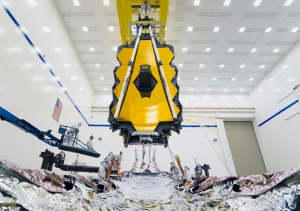After NASA launches the James Webb Space Telescope (JWST) on a historic mission this December, scientists anticipate their first glimpse of the most distant objects ever seen in the universe. Technology developed and tested at the University of Hawaiʻi Institute for Astronomy (IfA) and on Maunakea are behind JWST’s ability to gaze deeper into space than ever before.
Sixteen near-infrared (NIR) sensors known as HAWAII-2RGs are part of JWST’s science instruments, enabling it to capture near-infrared light from deep space, far surpassing the capability of NASA’s Hubble Space Telescope. These sensors are the culmination of years of research and development by IfA scientists and engineers. Early prototypes were developed and tested by UH astronomers Don Hall, Klaus Hodapp, and Doug Simons, along with IfA instrumentation engineer Shane Jacobson.
Testing on Maunakea

NASA selected IfA’s HAWAII-2RG sensors for use on the highly anticipated “next generation” space telescope after decades of testing and perfecting. These detectors not only met all design requirements, they also offered bonus features that made it easier for NASA to build JWST‘s three NIR instruments, which have very demanding environmental needs in deep space. An integral part of the testing process was the ability to mount the sensors on the IfA-operated UH 88-inch telescope on Maunakea, allowing for rapid and efficient evaluation of the detectors and testing over long periods of time to ensure no surprises on the upcoming mission.
“The extremely dark skies and exquisite image quality that we get from Maunakea allows us to really push technology hard and to explore where its limits are in terms of astronomical research potential,” said Simons, who serves as the IfA Director.
The JWST NIR detectors are the culmination of advancements made by UH and its industrial partner, Teledyne Imaging Sensors. Hall, who died in March 2020, pioneered the sensors, which are characterized by their unique combination of the metals mercury, cadmium, and tellurium (HgCdTe), producing semiconductors with an extremely high sensitivity. The sensors are from a line that IfA called the HAWAII (HgCdTe Astronomical Wide Area Infrared Imager) Arrays.
“I have absolute faith in our technology and NASA’s capabilities,” said Hodapp, “But this is an extremely complicated endeavor. For those of us involved with JWST, it’s months of nervous anticipation from launch to deployment a million miles away in space, to the unfolding of the instrument and eventual successful activation of the telescope.”
IfA has demonstrated its leadership in sensor development and adaptive optics technology, which has helped expand research capabilities in the astronomy field. Many ground-based telescopes on Maunakea and around the world use the H2RG detectors in their instruments. The predecessor of the H2RGs, called the H1RG, is also widely used in both ground-based observatories and in Hubble. IfA has also helped develop the latest generation sensors, H4RGs, which have 16 million pixels compared to the previous generation’s 4 million, and is expected to rapidly expand the technology into the future.
This research is an example of UH Mānoa’s goal of Excellence in Research: Advancing the Research and Creative Work Enterprise (PDF), one of four goals identified in the 2015–25 Strategic Plan (PDF), updated in December 2020.

